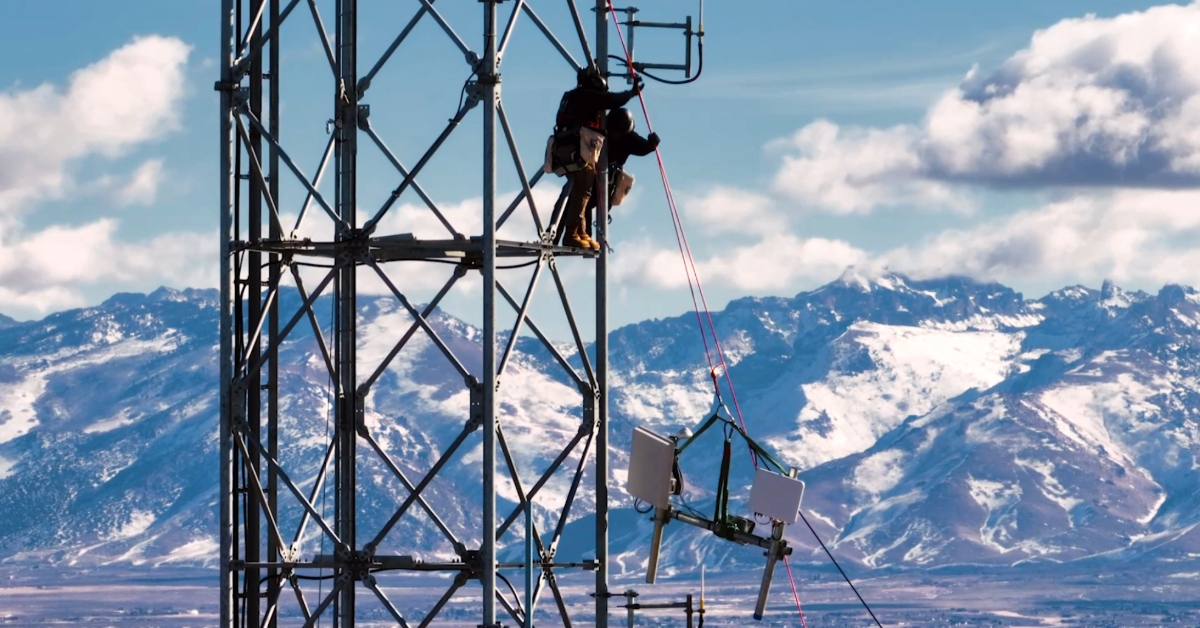A BEAD Success Story
Sky Fiber began its journey as a modest internet service provider launched by an electrical engineer in Reno, Nevada. In just a few years, the company has grown into a formidable regional operator, delivering broadband to both residential and enterprise customers throughout northern Nevada and into parts of California. The company’s success isn’t accidental—it’s the result of disciplined engineering, strategic foresight, and an embrace of next-generation fixed wireless access (ngFWA) that changed the economics of broadband deployment.
In 2025, Sky Fiber was awarded $180.6 million through the Broadband Equity, Access, and Deployment (BEAD) program to expand high-speed internet access to unserved and underserved communities in Nevada. Their strategy? A hybrid network architecture that blends the reach and speed of fiber with the agility and efficiency of Tarana’s revolutionary G1 ngFWA platform.
“We put in a lot of bids,” said Sean Duff, Director of Government Projects at Sky Fiber. “Forty-five percent of our proposals were a hybrid solution using both wireless and fiber. Our strategy was to deploy fiber in the more densely populated areas and Tarana everywhere else.”
This approach enabled Sky Fiber to dramatically lower project costs while still exceeding BEAD’s rigorous technical performance benchmarks. “We saw a 67% cost reduction by going hybrid instead of all-fiber,” Duff emphasized. “That brought our proposals in line with the state’s budget constraints, and they said, ‘Thank you very much.’”
G1: The Next Generation of FWA
Sky Fiber’s hybrid strategy wouldn’t have been feasible without Tarana’s next-generation fixed wireless access (ngFWA) platform. Tarana’s G1 introduces critical innovations that redefine the performance expectations for wireless broadband and make fiber-class connectivity possible in places where legacy FWA would fail. These breakthroughs include:
- Unmatched Interference Cancellation: G1’s interference cancellation ensures reliable, high-speed connectivity even in crowded, noisy RF environments. Features like Asynchronous Burst Interference Cancellation (ABIC) reduce the impact of bursty interference, such as nearby Wi-Fi transmitters. Less interference means more reliable, higher-speed connections.
- Superior Non-Line-of-Sight (NLoS) Performance: Rugged terrain and trees can hinder other wireless technologies, making links laggy or entirely unusable. G1 overcomes this with fine-grain Tx and Rx digital beamforming, distributed massive MIMO at both ends of the link, and perfect multipath integration.
- Scalability and Speed: Sky Fiber can deploy endgame broadband at large scale in weeks, not months or years. High-speed connectivity is deployed faster—accelerating service and revenue timelines—bridging the digital divide quickly, efficiently, and affordably.
“We liked the Tarana story and how it uses custom chipsets and algorithms versus off-the-shelf. We take advantage of everything Tarana can do,” shared Duff. “I’m a geek, I came from an RF background, and Tarana’s technology blew me away. We knew we had the right fit for what we needed,” said Duff.
Validating Performance for BEAD
BEAD funding isn’t handed out lightly. To be eligible, applicants must demonstrate that their proposed technology can meet or exceed specific speed, reliability, and coverage benchmarks—especially the minimum 100 Mbps download and 20 Mbps upload thresholds. Sky Fiber took this challenge seriously and did its homework before it ever submitted a bid.
“We knew we had to come in with proof,” Duff said. “Before even submitting bids, we conducted extensive work with Tarana engineers to validate our proposed coverage areas and real-world performance.”
“Wireless has its own challenges,” added Duff. “You’re constantly upgrading to deliver more bandwidth. People always want more. Today, 90% of our network is Tarana, so we’re comfortable with the performance. Tarana is delivering on its promises, and that’s refreshing.”
The numbers back this up. “We consistently get 400 Mbps and better,” concluded Duff. “Our density increase was just as dramatic. All of this puts us right in line with BEAD requirements.”
Coverage was equally critical. BEAD rules require full service to all eligible locations, including those obstructed by terrain or foliage. With Tarana, Sky Fiber could reach homes that had previously been unreachable. “We can serve customers that we couldn’t reach before. We have full non-line-of-sight (NLoS) links delivering well over the 100 Mbps required by BEAD,” Duff said. “We’re offering 100 Mbps and 250 Mbps packages for BEAD. We could offer more, but we chose to be conservative. However, the capability is there.”
Sky Fiber is already seeing results that Tarana can deliver in its existing network. Subscriber churn is down, and customer satisfaction is up. “We tried a lot of different solutions over the years. Almost every vendor you can think of,” said Duff. “Nothing performs like Tarana. Our customers love it. This gave us confidence when we put in our BEAD bids.”
Operational Improvements with ngFWA
Tarana’s benefits extend beyond performance. Its reliability and ease of deployment have also improved Sky Fiber’s operational efficiency.
“Once Tarana is installed, we don’t have to go back and touch it again. It just works,” said Duff. “Other vendors are a nightmare to deal with on installation and provisioning.”
Sales have also improved. “Tarana is an easier sell because of its compact form factor,” said Daniel Everson, Director of Sales & Marketing at Sky Fiber. “It’s much easier to promote than traditional systems with large, cumbersome dishes. That’s been a huge benefit.”
Thanks to Tarana’s NLoS capabilities, Sky Fiber now services previously inaccessible markets. “Tarana opened up our market 100%,” said Duff. “Now I’m competing with cable operators in areas I never could before. I can deliver 600 Mbps no problem. That gets us customers.”
This improved reliability, reduced installation time, lower support costs, and increased customer adoption all matter to BEAD-funded projects that must meet subscriber and service milestones on tight timelines.
BEAD Economics: Hybrid Makes the Math Work
Budget constraints are central to all government-funded broadband projects, and BEAD is no exception. Sky Fiber’s use of ngFWA played a key role in making their proposals financially viable.
“We looked at the numbers, and a hybrid approach made sense,” said Duff. “We can pull fiber to a key location and then use Tarana to cover the rest. The cost goes down dramatically, and we still deliver a high-quality product.”
This was particularly valuable in rural Nevada, where BEAD targets many sparsely populated areas. “A lot of BEAD project areas are big empty spaces. It’s not cost-effective to deploy fiber,” said Duff. “We asked ourselves, how do we get the biggest bang for the taxpayer’s buck?”
Deployment speed was another key advantage. Fiber networks can take months or years to build, but Sky Fiber’s hybrid model allows for much faster deployment while staying within the budget and required timeframe. “Running fiber everywhere would have put us over budget and way behind schedule,” said Duff.
Community Impact and BEAD’s Broader Goals
Sky Fiber is proving that a hybrid model combining fiber and ngFWA is a practical, cost-effective strategy for BEAD-funded broadband deployments. Fiber provides capacity in population centers, while Tarana everywhere else ensures universal coverage in a fraction of the time and cost.
Not only does this align with BEAD’s goals, but it’s a mission of delivering broadband that is deeply personal for Sky Fiber.
“Our ultimate goal is to build a reliable network and serve our clients,” Duff said. “These aren’t just customers. They’re our neighbors. Our kids go to school together, we see each other at the grocery store.”
Sky Fiber’s deployment isn’t just bringing faster internet. It’s transforming lives in rural communities. “We’re bringing new service to areas that were previously unserved. Places like remote clinics that need telemedicine, students who need to study online, and people looking for jobs.”
“Broadband is a utility. Everybody needs it. Just like water or electricity. The economic impact is going to be dramatic,” Duff concluded. “There will be connectivity everywhere, and it can attract new businesses that might not have considered these areas before. That means new jobs and stronger communities.”
Lessons for Other BEAD Applicants
Sky Fiber’s experience holds powerful lessons for other operators preparing BEAD submissions:
- Hybrid networks stretch BEAD dollars further without sacrificing performance.
- Tarana’s ngFWA technology is a proven complement for fiber in difficult or sparse terrain.
- Operational simplicity and faster time to revenue make ngFWA a competitive edge.
Most importantly, operators don’t have to choose between cost and quality. With the right tools, they can build affordable, high-performance broadband networks that change lives.
Looking back, Duff sees how their past experience created BEAD opportunity. “Could we have built a network with something other than Tarana? Technically, yes. Knowing what we know now, would we even entertain the idea? No. We would never have tried to bid for BEAD with another vendor.”
Conclusion: Innovation + Execution = BEAD Success
Sky Fiber’s story shows what’s possible when innovation meets pragmatism. Their success is proof that the future of broadband isn’t all fiber or all wireless—it’s both. By combining Tarana’s ngFWA platform with a strategic fiber backbone, they created a network that is scalable, fast, resilient, and financially sound.
This BEAD win is more than a milestone—it’s a blueprint. For every operator looking to make a competitive, credible bid for BEAD funding, Sky Fiber’s model shows the way forward.
And for unserved and underserved communities, it’s a lifeline to opportunity that can make the promise of BEAD a reality.
About Sky Fiber
SkyFiber Internet Services in Reno, NV, delivers the fastest internet speeds possible through fixed wireless, fiber, and LTE. Whether you are a local shop or a national chain, our broadband services can handle your needs, whether it’s internet service or online backup solutions. You can trust that your critical services won’t be interrupted with our reliable internet service. To learn more, visit SkyFiberInternet.com.
If you just can’t wait to learn more, check out our other blogs or some of our favorite customer links. Or reach out to us at info@taranawireless.com. We’d love to hear from you.


